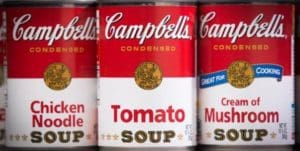Four years ago, Molly Kissell transitioned into the role Director of Integrated Demand Management at Campbell Soup. Campbell Soup’s demand forecast accuracy – as measured at the item/location one month following the forecast – had fallen into the mid-60s.

Demand Management Benchmarking
The initial goal was simply to achieve historical levels of forecast accuracy. For the first couple years, they explored various benchmarking solutions – including participation in Chainalytics’ Demand Planning Intelligence Consortium (DPiC) – and worked to improve planners’ capabilities to use their new demand management solution.
By 2015, Ms. Kissell explains, we had concluded that DPiC “was a great tool set to understand our capabilities and provide realistic aspirations” for improvement. For fiscal year 2017, “lag one forecastability” – the measure described above – was in the mid-70s – a substantial improvement.
But is 76 percent forecast accuracy good or bad? That is one of the benefits of DPiC benchmarking. DPiC focuses on “forecastability.” In other words, not all products and demand scenarios are equally easy to forecast. For some products, 76% accuracy falls well below expectations. For example, a product that possesses steady demand and requires little promotion. For newer, actively promoted products, 76% accuracy would be excellent. This concept is explained in greater detail in the article, “Robust Benchmarking is Still the Exception.”
Ms. Kissell continues “we are getting actionable insights that help us improve accuracy and drive better supply chain capabilities.” Accurate forecasts help companies reduce inventory levels while improving service. Campbell Soup’s primary measure of service includes case fill accuracy for its customers, inventory measured by days of coverage, and the amount of inventory written off for obsolescence. Forecast accuracy remains important, but these metrics, driven by accuracy, ultimately “drive the bottom line.”
Planners use DPiC’s actionable insights to target the top ten items driving the most improvement, where improvement is measured by fast moving SKUs with high forecast errors, inventory levels, or service issues. In terms of assessing raw materials that comprise a finished product, and applying the forecast upstream, “a better forecast may not matter if there are other ways to manage volatility. We are using actionable insights “to Improve the forecast in places where it does matter.”
The DPiC benchmarking has positive effects on the demand management department as well. Ms. Kissell points out that it is “more motivating to have individual targets that are well thought out, with proof that you can achieve them.” In contrast, many organizations’ forecasting goals can feel arbitrary and impossible to achieve. Realistic targets help employees to understand that when their forecast accuracy appears to be low, they may actually be exceling.
But good benchmarking helps organizations “manage expectations both up and down.” Ms. Kissell uses the benchmark data to help the executive leadership “have a better understanding of what is realistic. If the benchmarking demonstrates a target as unachievable, they reevaluate target goals. “The data allows me to go in with rich analytic support I would not have had otherwise. The conversations are moving in the right direction.”
The DPiC data shows the Campbell’s US Retail and Food Service business, the division using this solution, is operating at well above average performance. Consequently, Ms. Kissell explained, “We are looking to expand the use of the Chainalytics solution more broadly with our other divisions. Chainalytics has been a key ingredient in a more holistic strategy to improve our results by strengthening our processes, people, and tools.”
















